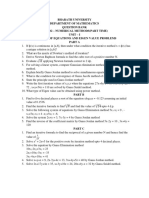0 ratings0% found this document useful (0 votes)
6 viewscm
Computational methods question paper
Uploaded by
cm04120210Copyright
© © All Rights Reserved
Available Formats
Download as PDF or read online on Scribd
0 ratings0% found this document useful (0 votes)
6 viewscm
Computational methods question paper
Uploaded by
cm04120210Copyright
© © All Rights Reserved
Available Formats
Download as PDF or read online on Scribd
You are on page 1/ 2
(Please write your Exam Roll No.) Exam Rolt No. ..
END TERM EXAMINATION
‘THIRD SEMESTER [B.Trcu.] FEBRUARY 2023
(Paper Code: ES-201 Subject: Computational Methods
Time: 3 Hours Maximum Marks: 75
Note: Attempt any five questions including Q.No.1 which is
compulsory. Select one question from each unit.
Assume missing data, if any. Scientific calculator is allowed.
Ql fa) In the subtraction of 37.593621-37.584216, how many significance will
be lost. (1.5)
Ab) How many steps of the bisection algorithm are needed to compute a root
of f(x) to full machine single precision on a 32-bit word length computer if
a=16 and b*17. (1.5)
“(€) Using Simpson's 1/3 rule compute the integral (-"” /sin(@) dxfor n=4
with an accuracy to five decimal places. (1.5)
(a) Using Lagrange interpolation find the unique polynomial of degree 2,
ge interpo!
such that f0}=1, {(1)=3, £(3)}=55. (1.5)
Ae) Define eigtn Values of a matrix and eigen values of the matrix (1.5)
(A Define Cubic Spline function and write the conditions required for cubic
spline interpolation {1.5)
(8) Solve VP = x +y,y(0) = 1 using Picard’s method upto 2 iterations.
(3)
(h) Classify whether the equations are hyperbolic, elliptical or parabolic:
(Wet gs + 60S Y Ugy — Uyy = 0
(ug, + Uy + uy + sinx ty — u = x? + y? (3)
UNIT —1
ree 2 If the secant method is used onf(x) = x5 + x? +3 with xp = —1and y=
1, what will be x5? 3)
If ffx) = 3x-cos(x]-1 and xo= 0.6, what are x, and x2 in the Newton
iteration? (7 .
#Q3 a} Minimize the function ffx) = 4x?+27-7x+14 within the interval [0,1]
using golden section method. (7.5)
b) Find minimum value of f(x,,22) = x, — xz + 2x} + 2x,x, + x} using steepest
decent method taking starting point xo(0, 0). (7.5)
UNIT-T
Q4 a) Prove that ex = (“) ex 5 the interval of differentiation being unity. (6.5)
b) Construct a divided difference table for the function f(x) given in the
following table and find the Newton divided difference interpolating
polynomial of fq
xii 3/2 oO 2
[3 [isa [3 [5/3
Also find £(0.5). (8-5)
P.T.O.
https://www.ggsipuonline.com
Qs
bay
{a) If the integral f" e°°**dx is to be computed with absolute error less than
}* 107%, and if we are going to use composite trapezoidal rule with a
uniform partition, how many subintervals are needed? (6)
(b) Evaluate the definite integral [e-*dx using the basic Simpson’s 1/3
rule and the basic Simpson’s.3/8 rule carries five significant digits. Also,
find the length of correctness in the significant decimal places (rounded)
in both the rules. 3)
UNIT-In
(a) Show that the system of equations:
% + 4x, + ax =6
2x4 — x2 + Zax, = 3
ax, + 3x2 +4, =5
Fossesses a unique solution when a=0, no solution when ax -1 and
infinitely many solution when a =1. (6)
(®) Solve the system of linear equations:
[enone +y=1
x+y=2
‘Using Gauss elimination method in order to apply no pivoting and partial
pivoting. Also analyse, how roundoff error effect the computation if the
calculation carry at most five significant digits of precision (rounding). (9)
Q7 Aa) Determine the largest cigen value and the corresponding eigen vector of
2 -1 0
the matrix [ 1 2 “| using power series method taking starting eigen
oO -1 2
1
vector « fa. ‘6
9)
) Determine the Cholesky factorization of the matrix A, where A is:
42 3
ie 8 2| 9)
3 22 82!
UNIT =v
ae
oe
pi) Using Taylor's series method, compute y{0.2) to three decimal precision
from $= 1 ~ 2xy given that y(0) = 0. Compare the result with the exact
result for the value of y at 0.2, https:/Avww.ggsipuonline.com (7.5)
=< -t-1)?
Consider the initial value problem Ce f G@—t-2" | Using Runge-
Kutta method of 4 order find x(1.5) taking h=0.5 (7.5)
(a) Solve the initial value problem 2 = 1+ xy?,y(0) = 1 and find y(0.4) using
Milne’s method, when it is given that: (6)
x [OL 0.2 | 03
1.105 [1.223 | 1.355
(®) Solve the partial differential equation
Uxe + Uy = —Bizy, O
You might also like
- Candidates Are Required To Give Their Answers in Their Own Words As Far As PracticableNo ratings yetCandidates Are Required To Give Their Answers in Their Own Words As Far As Practicable6 pages
- 1154 MATH F313 20221227084943 Comprehensive Exam Question Paper-2No ratings yet1154 MATH F313 20221227084943 Comprehensive Exam Question Paper-22 pages
- It Is Compulsory To Submit The Assignment Before Filling in TheNo ratings yetIt Is Compulsory To Submit The Assignment Before Filling in The6 pages
- 339 - UG Mathematics VI SEM 2018-19 Without GENo ratings yet339 - UG Mathematics VI SEM 2018-19 Without GE16 pages
- Differential Equations Numerical Methods 22MTC04 (1)No ratings yetDifferential Equations Numerical Methods 22MTC04 (1)2 pages
- Numerical Methods and Differential Equations: Code: EE3T1No ratings yetNumerical Methods and Differential Equations: Code: EE3T13 pages
- Engineering Mathematics Test 5: Numerical MethodsNo ratings yetEngineering Mathematics Test 5: Numerical Methods6 pages


























































